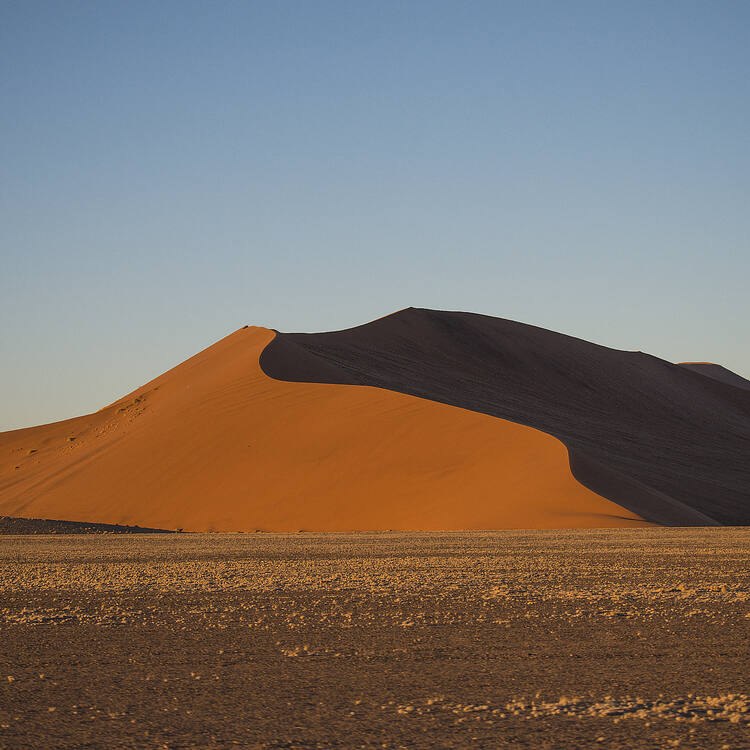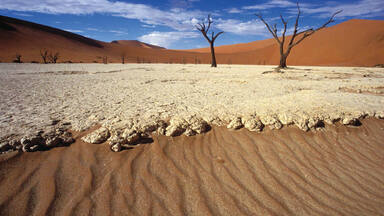Namib Sand Sea
Namib Sand Sea
Namib Sand Sea is the only coastal desert in the world that includes extensive dune fields influenced by fog. Covering an area of over three million hectares and a buffer zone of 899,500 hectares, the site is composed of two dune systems, an ancient semi-consolidated one overlain by a younger active one. The desert dunes are formed by the transportation of materials thousands of kilometres from the hinterland, that are carried by river, ocean current and wind. It features gravel plains, coastal flats, rocky hills, inselbergs within the sand sea, a coastal lagoon and ephemeral rivers, resulting in a landscape of exceptional beauty. Fog is the primary source of water in the site, accounting for a unique environment in which endemic invertebrates, reptiles and mammals adapt to an ever-changing variety of microhabitats and ecological niches.
Description is available under license CC-BY-SA IGO 3.0
Erg du Namib
Le site qui s’étend sur plus de trois millions d’ha. - plus une zone tampon de 899 500 ha. - est le seul désert côtier où l’on trouve de vastes champs de dunes de sable sous l’influence du brouillard. L’Erg est composé de deux systèmes dunaires, un système ancien semi-consolidé sur lequel se superpose un système plus jeune et plus actif. L’endroit est exceptionnel car les dunes sont constituées de matériaux venus de loin, transportés depuis l’intérieur de l’Afrique australe par les cours d’eau, les courants océaniques et le vent. Le site comprend également des plaines de gravier, des cuvettes côtières, des collines rocheuses, des inselbergs à l’intérieur de l’erg, un lagon côtier, des cours d’eau éphémères, le tout formant un paysage d’une beauté exceptionnelle. Le brouillard est ici la principale source d’eau, contribuant à un environnement, unique à une telle échelle, où invertébrés, reptiles et mammifères endémiques s’adaptent à une grande variété de micro-habitats et de niches écologiques toujours changeantes.
Description is available under license CC-BY-SA IGO 3.0
Arenal de Namib
source: UNESCO/CPE
Description is available under license CC-BY-SA IGO 3.0
ナミブ砂海
霧が独自の生物を育む海岸砂漠。ナミビアの大西洋岸に広がり、霧に覆われた広大な砂漠や砂丘が見られる世界で唯一の海岸砂漠。川の流れや海流、風を介してアフリカ大陸内部から砂が運ばれ、現在も形成され続けているこの砂漠は、島状丘や平原、底の平らな窪地などの様々な地形が見られ、美しく広大であるとともに、風による砂と生物の相互作用の顕著な例である。砂漠環境に適応した特殊な固有の動植物が生息・生育しており、砂と風と霧により変化し続ける環境という極限状態での生物進化は無類のものとなっている。source: NFUAJ
Namibische zandzee
De Namibische zandzee is de enige kustwoestijn ter wereld die uitgestrekte duingebieden omvat die beïnvloed worden door mist. Het gebied – met een oppervlakte van meer dan drie miljoen hectare en een bufferzone van 899.500 hectare – bestaat uit een oud semigeconsolideerd duinsysteem bedekt door een jonger actief systeem. De duinen worden gevormd door het transport – via rivier, oceaanstroming en wind – van materiaal uit het achterland dat duizenden kilometers verderop ligt. De kustwoestijn bestaat uit gravelvlaktes, kustlaagtes, rotsachtige heuvels, inselbergs in de zandzee, een kustlagune en tijdelijke rivieren. De primaire bron van water in de woestijn is mist.
Source: unesco.nl
Outstanding Universal Value
Brief Synthesis
The Namib Sand Sea lies along the arid African coast of the South Atlantic lying wholly within Namibia’s Namib-Naukluft Park. It covers an area of 3,077,700 hectares, with an additional 899,500 hectares designated as a buffer zone.
The Namib Sand Sea is a unique coastal fog desert encompassing a diverse array of large, shifting dunes. It is an outstanding example of the scenic, geomorphological, ecological and evolutionary consequences of wind-driven processes interacting with geology and biology. The sand sea includes most known types of dunes together with associated landforms such as inselbergs, pediplains, and playas, formed through aeolian depositional processes. It is a place of outstanding natural beauty where atmospheric conditions provide exceptional visibility of landscape features by day and the dazzling southern hemisphere sky at night.
Life in the fog-bathed coastal dunes of the Namib Sand Sea is characterised by very rare behavioural, morphological and physiological adaptations that have evolved throughout its specialist communities. The large number of endemic plants and animals are globally-important examples of evolution and the resilience of life in extreme environments.
Criterion (vii):The property is the world’s only coastal desert that includes extensive dune fields influenced by fog. This alone makes it exceptional at a global scale, but it also represents a superlative natural phenomenon on account of the three-part ‘conveyor system’ which has produced the massive dune field from material transported over thousands of kilometres from the interior of the African continent by river erosion, ocean currents and wind. Most dune fields elsewhere in the world are derived from bedrock eroded in situ. The age, extent and height of the dunes are outstanding and the property also exhibits a range of features that give it exceptional aesthetic qualities. The diversity of dune formations, their ever-changing form and the range of colour and texture create landscapes of outstanding natural beauty.
Criterion (viii): The property represents an exceptional example of ongoing geological processes involving the formation of the world’s only extensive dune system in a coastal fog desert through transport of material over thousands of kilometres by river, ocean current and wind. Although the nominated area encompasses only the Aeolian elements of this ongoing geological process the other elements of the ‘conveyor system’ are assured. The diversity of the ever-changing dune formations, sculpted by pronounced daily and seasonal changes in dominant wind directions is also exceptional at a global scale within such a relatively small area.
Criterion (ix): The property is an exceptional example of ongoing ecological process in a coastal fog desert where plant and animal communities are continuously adapting to life in a hyper arid environment. Fog serves as the primary source of water and this is harvested in extraordinary ways while the ever-mobile wind-blown dunes provide an unusual substrate in which well-oxygenated subsurface sand offers respite and escape for ‘swimming’ and ‘diving’ invertebrates, reptiles and mammals. The outstanding combination and characteristics of the physical environment – loose sand, variable winds and fog gradients across the property – creates an ever-changing variety of micro-habitats and ecological niches that is globally unique on such a scale.
Criterion (x): The property is of outstanding importance for the in-situ conservation of an unusual and exceptional array of endemic species uniquely adapted to life in a hyper-arid desert environment in which fog serves as the primary source of water. These are mostly invertebrate animals and display a range of very rare behavioural and physiological adaptations to the desert environment where they live that contributes significantly to the property’s OUV.
Integrity
The boundaries of the property encompass all the elements of the Namib Sand Sea that exemplify its Outstanding Universal Values. These elements are well conserved and included at a scale appropriate to maintaining ongoing dynamic processes. The large size of the area (30,777 km2) ensures that all the active and underlying (fossilized) dune formations and features, causative processes and ancillary habitats are included. The extensive dune-scapes are unspoilt and continuously refreshed and maintained by wholly natural processes. Because of its vast size, difficulty of access and current management within the protected Namib-Naukluft Park (49,768 km2), the Namib Sand Sea is well conserved and in an excellent, undamaged state. Permanent visitor and management infrastructure is non-existent within the boundaries of the property and visitation is restricted to small, temporary point locations that have no measurable effect on the area.
Protection and management requirements
The Namib Sand Sea has been under conservation management for more than 50 years with well-established management and resource allocation systems, based on regularly revised and updated management plans and long-term budgetary planning. Prior to establishment of conservation management, the area was protected for its potential as a diamond-mining area, but this was never realised. Key management issues today include managing the increasing demand for visitor access to pristine areas and precluding mineral exploration rights that would impact on the values and attributes of the area. There is potential for serial extension of the Namib Sand Sea beyond the Namib-Naukluft Park and beyond national borders to include other significant dune systems within other protected areas of the larger Namib Desert.

